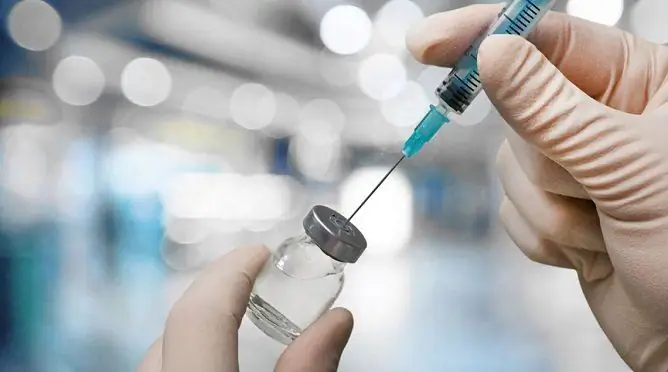- Author Rachel Wainwright [email protected].
- Public 2023-12-15 07:39.
- Last modified 2025-11-02 20:14.
Prevenar 13
Prevenar 13: instructions for use and reviews
- 1. Release form and composition
- 2. Pharmacological properties
- 3. Indications for use
- 4. Contraindications
- 5. Method of application and dosage
- 6. Side effects
- 7. Overdose
- 8. Special instructions
- 9. Application during pregnancy and lactation
- 10. Use in childhood
- 11. Use in the elderly
- 12. Drug interactions
- 13. Analogs
- 14. Terms and conditions of storage
- 15. Terms of dispensing from pharmacies
- 16. Reviews
- 17. Price in pharmacies
Latin name: Prevenar 13
ATX code: J07AL02
Active ingredient: polysaccharides of 13 pneumococcal serotypes: 1, 3, 4, 5, 6A, 6B, 7F, 9V, 14, 18C, 19A, 19F, 23F, CRM197 carrier protein
Manufacturer: Wyeth Pharmaceuticals Division of Wyeth Holdings Corporation (USA), Baxter Pharmaceuticals Solutions LLS (USA), Pfizer Ireland Pharmaceuticals (Ireland), NPO Petrovax Pharm LLC (Russia)
Description and photo update: 2018-26-10
Prices in pharmacies: from 1799 rubles.
Buy

Prevenar 13 is a vaccine (pneumococcal polysaccharide conjugated adsorbed, 13-valent) for the prevention of diseases caused by Streptococcus pneumoniae.
Release form and composition
Prevenar 13 is produced in the form of a suspension for intramuscular (i / m) administration: a white solution with a homogeneous structure (0.5 ml in a glass transparent syringe without color with a capacity of 1 ml: in a plastic package 1 syringe complete with 1 sterile needle, cardboard box 1 pack; for medical institutions - in a plastic package 5 syringes, in a cardboard box 2 packages complete with 10 sterile needles; 100 syringes in a plastic container).
0.5 ml (1 dose) of the suspension contains:
- active ingredients: pneumococcal conjugates (polysaccharide - CRM 197) - polysaccharide serotype 1, 3, 4, 5, 6A, 7F, 9V, 14, 18C, 19A, 19F and 23F - 2.2 μg each, polysaccharide serotype 6B - 4, 4 μg, CRM 197 carrier protein approximately 32 μg;
- auxiliary components: polysorbate 80, aluminum phosphate, succinic acid, sodium chloride, water for injection.
Pharmacological properties
Prevenar 13 is a vaccine presented as capsular polysaccharides of pneumococcal serotypes: 1, 3, 4, 5, 6A, 6B, 7F, 9V, 14, 18C, 19A, 19F and 23F. Each of them is individually conjugated to the CRM 197 diphtheria protein and is adsorbed on aluminum phosphate. After the introduction of the vaccine, the immunomodulatory effect occurs on the basis of the production of antibodies in the body to each of the capsular polysaccharides of Streptococcus pneumoniae, providing specific protection against infections caused by the pneumococcal serotypes included in the preparation.
Prevenar 13 contains 90% of the serotypes that cause the development of invasive pneumococcal infections (IPIs) that are resistant to antibiotics.
For conjugated pneumococcal vaccines, according to the recommendations of the World Health Organization, the equivalence of the immune response of the vaccine is determined by three criteria. The first criterion is the percentage of patients in whom the concentration of specific IgG antibodies has reached or exceeds 0.35 μg per 1 ml. The second criterion is CGC (geometric mean concentration) of Ig and OFA (opsonophagocytic activity) of bactericidal antibodies, where the OFA titer is equal to or exceeds the ratio of 1 to 8. The third criterion is CGT (geometric mean titer). For adults, the protective level of antipneumococcal antibodies has not been established, therefore, serotype-specific OPA (SGT) is used.
During the primary vaccination using three doses of Prevenar 13 in children under 6 months of age, there is a significant increase in the level of antibodies to all serotypes of the vaccine. Against the background of only two doses for serotypes 6B and 23F, the first criterion of the vaccine immune response is determined in a smaller percentage of children. At the same time, there is a pronounced booster response to revaccination for all serotypes. For the formation of immune memory, the use of three and two doses for primary vaccination is shown. In children of the second year of life, the secondary immune response to the booster dose is comparable for all 13 serotypes after a series of primary vaccinations using three and two doses of the vaccine.
Vaccination after 8 weeks of life of premature babies (gestational age up to 37 weeks), including those born at a gestational age of up to 28 weeks, after the completion of the full course leads to the achievement of values of the level of protective specific antipneumococcal antibodies and their OPA, which exceed the protective ones in 87-100% of vaccinated children to all 13 serotypes.
A single dose of Prevenar to 13 children from 5 to 17 years old can give the necessary immune response to all the polysaccharides of Streptococcus pneumoniae that make up the vaccine.
When compared with the Prevenar vaccine, the presence of additional (1, 3, 5, 6A, 7F, 19A) vaccine-specific serotypes in Prevenar 13 significantly increases its effectiveness.
After vaccination with Prevenar (according to the scheme of two doses in the first year of life and a single revaccination in the second year of life), covering 94% of children, the incidence of invasive pneumococcal infection (IPI) reaches 98% after 4 years. After switching to Prevenar 13 vaccine, there is a tendency for a further decrease in the frequency of IPI. In children under the age of 2 years, this occurs in 76% of cases, at the age of 5-14 years - in 91%. There are no cases of IPI caused by serotype 5. In children aged 5 years and younger, the serotype-specific efficacy against IPI for additional vaccine serotypes 3 and 6A ranges from 68 to 100%, respectively, and for serotypes 1, 7F and 19A it was 91%.
The frequency of registration of IPI caused by serotype 3, while using Prevenar 13, decreased by 68% in children under 5 years of age.
Switching to Prevenar 13 after the introduction of the Prevenar vaccine according to the 2 + 1 scheme, the incidence of otitis media caused by serotypes 4, 6B, 9V, 14, 18C, 19F, 23F and serotype 6A is reduced by 95%, by serotypes 1, 3, 5, 7F and 19A by 89%.
In addition, with this transition in children from 1 month of age to 15 years, there is a 16% decrease in the frequency of all cases of community-acquired pneumonia. Cases of community-acquired pneumonia with pleural effusion decreased by 53%, pneumococcal - by 63%. In the second year after the introduction of Prevenar 13, the incidence of community-acquired pneumonia caused by additional vaccine serotypes decreased by 74%.
In children under 5 years of age, vaccination with Prevenar 13 according to the 2 + 1 scheme reduces the number of hospitalizations with alveolar community-acquired pneumonia of any etiology by 32% and outpatient visits by 68%.
The effectiveness of the drug has been demonstrated against vaccine-specific serotypes of the nasopharynx.
A serotype-specific decrease in the incidence of unvaccinated individuals can be noted only in countries where mass immunization of the population has been carried out for more than 3 years in compliance with the established scheme. In unvaccinated persons 65 years of age and older, invasive pneumococcal infection occurs 25% less, caused by serotypes 4, 6B, 9V, 14, 18C, 19F, 23F - decreased by 89% and serotypes 1, 3, 5, 6A, 7A, 19A - by 64%.
The incidence of infections caused by serotype 3 decreased by 44%, serotype 6A by 95%, and serotype 19A by 65%.
According to the results of clinical studies, the safety and immunogenicity of the drug has been demonstrated for patients aged 18 years and older, including those previously vaccinated with a 23-valent pneumococcal polysaccharide vaccine (PPV23). Immunological equivalence is observed in relation to 12 common serotypes with PPV23. In addition, the unique serotype 6A and 8 common serotypes with PPV23 demonstrated a higher immune response to Prevenar 13 vaccine.
In patients aged 70 and older, after a single vaccination more than 5 years ago with PPV23, revaccination with Prevenar 13 gives a more pronounced immune response.
The administration of two doses of Prevenar to 13 patients with sickle cell disease aged 6 to 18 years with an interval of 6 months produces a high immune response.
The introduction of the first dose to children and adults who have not previously received pneumococcal vaccine infected with human immunodeficiency virus (HIV) leads to an increase in IgG FGC and OFA. The introduction of the second and third doses of the vaccine with an interval of 6 months makes it possible to achieve a higher immune response than with a single vaccination.
Hematopoietic stem cell transplantation is associated with a high risk of developing pneumococcal infection. Therefore, patients over 2 years of age who have undergone allogeneic hematopoietic stem cell transplantation (HSCT), with complete or satisfactory partial hematological remission in the case of lymphoma and myeloma, are shown vaccination with three doses of Prevenar 13 with an interval of 1 month. Vaccination is started 3-6 months after HSCT. 6 months after the third dose, a booster (fourth) dose of the vaccine is administered. One month after the fourth dose of Prevenar 13, a single dose of PPV23 is recommended.
Indications for use
According to the instructions, Prevenar 13 is indicated for patients from 2 months of age and older for the prevention of pneumococcal infections caused by Streptococcus pneumoniae serotypes 1, 3, 4, 5, 6A, 6B, 7F, 9V, 14, 18C, 19A, 19F and 23F, including invasive forms such as meningitis, severe pneumonia, sepsis, bacteremia, and non-invasive - community-acquired pneumonia, otitis media.
Vaccination is carried out in accordance with the approved terms within the framework of the national calendar of preventive vaccinations and with an increased risk of developing pneumococcal infection.
Conditions at increased risk of developing pneumococcal infection include immunodeficiency (including human immunodeficiency virus infections), immunosuppressive therapy for cancer, anatomical and functional asplenia, a cochlear implant (including planned surgery), cerebrospinal fluid leakage, chronic diseases of the cardiovascular system, lungs, kidney and (or) liver, diabetes mellitus, bronchial asthma, convalescent period of meningitis, acute otitis media or pneumonia, infection with mycobacterium tuberculosis.
In addition, the risk of developing pneumococcal infection is increased in tobacco smokers, patients over the age of 50, often and long-term ill children, premature babies in organized groups of people (including boarding schools, orphanages, army groups).
Contraindications
- acute period of infectious, non-infectious and chronic diseases (until complete recovery or the onset of a period of remission);
- severe generalized allergic reactions, anaphylactic shock and other hypersensitivity reactions with previous administration of Prevenar 13 or Prevenar;
- individual intolerance to the components of the drug.
Instructions for use of Prevenar 13: method and dosage
Do not inject the drug intravascularly and intramuscularly into the gluteal region.
The suspension is injected intramuscularly, in children of the first years of life - into the upper outer surface of the middle third of the thigh, over 2 years - into the deltoid muscle of the shoulder.
Shake the contents of the syringe well before use. It is possible to use the drug if, upon visual inspection, the suspension has a homogeneous structure. Do not use Prevenar 13 in the presence of foreign particles in the contents of the syringe.
A single dose for patients of any age is 0.5 ml.
It is important to note: if vaccination is started with a pneumococcal polysaccharide conjugate adsorbed 13-valent vaccine, then it is recommended to complete it with the same vaccine. If vaccination is started with the 7-valent Prevenar vaccine, then it can be continued with Prevenar 13 at any stage of the immunization schedule.
If the interval between vaccine administration is increased for objective reasons, the introduction of additional doses of Prevenar 13 is not required.
For individual immunization of children aged 2-6 months, the 3 + 1 scheme is used: the first dose is administered at the age of 2 months, then the second and third doses are administered with an interval of at least 1 month between injections. Revaccination is a single dose at the age of 11-15 months.
When carrying out mass immunization of children aged 2-6 months, use the 2 + 1: 2 dose regimen with an interval of at least 2 months between injections. Revaccination is a single administration of a single dose at the age of a child of 11-15 months.
When immunizing children 7-11 months old, a 2 + 1: 2 dose regimen is used with an interval of at least 1 month between injections. Revaccination is a single dose at the age of 11-15 months.
When vaccinating children aged 12-23 months, a 1 + 1: 2 dose regimen is used with an interval between injections of at least 2 months.
Children 24 months of age and older are vaccinated with a single dose of the vaccine.
Patients aged 18 years and older are shown a single dose of the drug, the need for revaccination has not been established. The interval between the administration of Prevenar 13 and PPV23 vaccines is prescribed in accordance with the officially established methodological recommendations.
After transplantation of hematopoietic stem cells, patients are shown immunization, consisting of 4 doses of 0.5 ml of Prevenar 13, according to the 3 + 1 scheme. The first dose is recommended to be administered from the 3rd to the 6th month after transplantation. The next two doses are administered 1 month apart between injections. Revaccination - one dose 6 months after the third dose.
Vaccination of premature infants is carried out according to the 3 + 1 scheme. The first dose should be administered at the age of 2 months, regardless of the child's body weight. Then, with an interval of 1 month between injections, 2 more doses of Prevenar 13 are administered. The fourth (booster) dose is recommended to be administered at the age of 12-15 months.
The use of Prevenar 13 in old age is shown, the safety and immunogenicity of the drug have been confirmed for this category of patients.
Side effects
- very often: at the injection site - skin redness, swelling or induration up to 7 cm in diameter, painful sensation [in children 2-5 years of age and (or) after revaccination]; headache, worsening sleep, drowsiness, decreased appetite, exacerbation of existing or the appearance of generalized new pain in joints and muscles, chills, fatigue, vomiting (in patients 18-49 years old); hyperthermia; irritability;
- often: soreness at the injection site, causing a short-term limitation of the range of motion of the limb; an increase in body temperature above 39 ° C; edema or induration 2.5-7 cm in diameter, hyperemia at the injection site (in children under 6 months of age after a series of primary vaccinations), rash, vomiting, diarrhea;
- infrequently: reactions at the injection site - skin redness, swelling or induration more than 7 cm in diameter, individual intolerance (itching, urticaria, dermatitis); nausea, convulsions (including febrile convulsions), tearfulness;
- rarely: reactions at the injection site - lymphadenopathy; flushing of the face, cases of hypotonic collapse, hypersensitivity reactions (including bronchospasm, shortness of breath, Quincke's edema localized in the face and other organs), anaphylactic or anaphylactoid reaction (including shock);
- very rare: regional lymphadenopathy, erythema polyform.
In adults, previously vaccinated and unvaccinated with 23-valent pneumococcal polysaccharide vaccine, there were no significant differences in the incidence of undesirable effects.
Overdose
Since Prevenar 13 is available in syringes with only one dose, overdose is unlikely.
special instructions
Immunization is carried out in a specialized medical office provided with anti-shock therapy. Due to the risk of developing anaphylactic reactions after injection, the patient's condition should be monitored for 0.5 hour.
Immunization against pneumococcal infection in a premature baby born at a gestational age of less than 37 weeks is necessary for infants in the first months of life, especially with immaturity of the respiratory system. Therefore, one should not postpone the vaccination or refuse it. The procedure is carried out at the second stage of nursing in a hospital under the close medical supervision of the child's condition within 48 hours after vaccination. The nature, severity of post-vaccination reactions and the frequency of their development during vaccination of premature babies (including deeply premature babies and those with extremely low body weight) do not differ from those in full-term babies.
With the primary vaccination with Prevenar 13, the incidence of local reactions in older children is higher than in children of the first year of life.
It is recommended to be careful when administering the drug to patients with blood coagulation disorders (including thrombocytopenia) or on anticoagulant therapy. Vaccination in this category of persons can be carried out only after achieving control of hemostasis and stabilization of their condition. If necessary, the subcutaneous administration of the suspension is indicated.
For the prevention of pneumococcal infection caused by serotypes, the antigens of which are not present in Prevenar 13, this vaccine should not be used. Primary vaccination in high-risk children under 2 years of age should be age-appropriate. In case of impaired immunoreactivity, administration of the drug may cause a decrease in the level of antibody production.
Immunization for the formation of immune memory against pneumococcal infection is recommended to start with a 13-valent vaccine. The need for revaccination has not been established. Subsequent administration of PPV is possible to expand serotype coverage in high-risk individuals.
Immunization of children at high risk (including patients with sickle cell anemia, asplenia, with HIV infection, immune dysfunction, chronic disease) after Prevenar 13 can be continued with the introduction of PPV23 after 2 months.
Patients previously vaccinated with PPV23 (one or more doses) may be given at least one dose of 13-valent vaccine.
In the Russian Federation, vaccination with Prevenar 13 is recommended for all persons over 50 years of age, as well as for patients at risk. As a revaccination, it is possible to introduce PPV23 after 2 months.
The vaccine is stable at temperatures up to 25 ° C for 4 days (within the specified shelf life). This information is reported for making a decision on the use of the drug during temporary temperature fluctuations during storage or transportation. Transportation can be carried out at a temperature of 2-25 ° C for no more than 5 days.
Influence on the ability to drive vehicles and complex mechanisms
After direct administration of the vaccine, care should be taken when driving vehicles and mechanisms, since a temporary violation of psychomotor reactions is possible.
Application during pregnancy and lactation
The safety of using Prevenar 13 during gestation and breastfeeding has not been established.
There is no information on the penetration of vaccine antigens or post-vaccination antibodies into breast milk.
Pediatric use
Shown for use in children aged 2 months.
Use in the elderly
Shown the use of Prevenar 13 in old age.
Drug interactions
There is no information on the interchangeability of Prevenar 13 when vaccinated with other pneumococcal conjugate vaccines. During immunization with Prevenar 13, simultaneous vaccination with other vaccines is allowed if they are administered to different parts of the body.
In children aged 2 months to 5 years, Prevenar 13 can be combined with any vaccines that are included in the immunization calendar of children in the first years of life, tuberculosis cream (BCG). Simultaneous administration of antigens that are part of monovalent and combined vaccines, such as tetanus, diphtheria, acellular or whole-cell pertussis, poliomyelitis antigens, Haemophilus influenzae (type b) antigens, hepatitis A or B, mumps, measles, varicella, rubella infections, the immunogenicity of Prevenar 13 and these vaccines is not affected.
Children with seizure disorders (including a history of febrile seizures), as well as with the simultaneous administration of whole-cell pertussis vaccines, increase the risk of developing febrile reactions. The symptomatic use of antipyretics should be advised.
There is no information on the possibility of simultaneous use of Prevenar 13 in patients aged 6-17 years with conjugated meningococcal vaccine, vaccine against human papillomavirus infection, tick-borne encephalitis, tetanus, diphtheria and pertussis.
For patients aged 50 and over, the 13-valent vaccine can be used in combination with the 3-valent inactivated seasonal influenza vaccine (DVT). In this case, the immune response to the DVT vaccine does not change, and the immune response to Prevenar 13 decreases.
Analogs
The analogues of Prevenar 13 are Pnevmo 23, Prevenar.
Terms and conditions of storage
Keep out of the reach of children.
Store at temperatures up to 2-8 ° C, keep away from freezing.
The shelf life is 3 years.
Terms of dispensing from pharmacies
A pack of 1 syringe is available by prescription, a pack of 10 syringes is supplied to health care facilities.
Reviews about Prevenar 13
Reviews about Prevenar 13 are mostly positive. Many mothers point to good tolerance, absence of adverse reactions, free vaccination. The advantages of the vaccine include its effectiveness in developing immunity immediately to 13 pneumococcal infections.
Price for Prevenar 13 in pharmacies
The price of Prevenar 13 for a package containing 1 syringe-dose (0.5 ml) can range from 1,863 rubles.
Prevenar 13: prices in online pharmacies
|
Drug name Price Pharmacy |
|
Prevenar 13 pneumococcal vaccine 0.5 ml / dose suspension for intramuscular administration 0.5 ml 1 pc. 1799 RUB Buy |

Anna Kozlova Medical journalist About the author
Education: Rostov State Medical University, specialty "General Medicine".
Information about the drug is generalized, provided for informational purposes only and does not replace the official instructions. Self-medication is hazardous to health!






